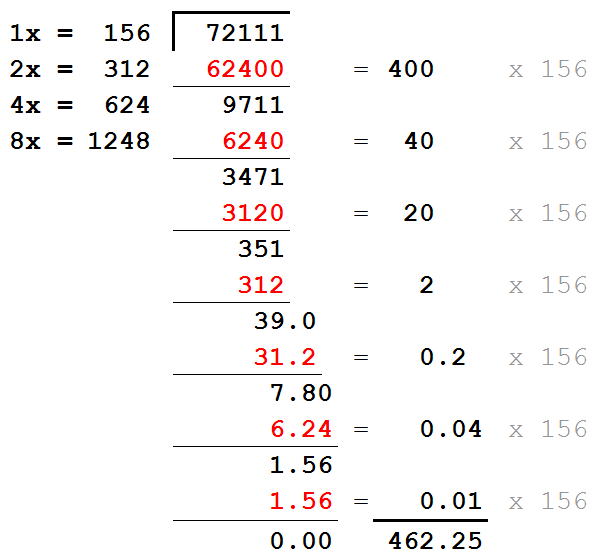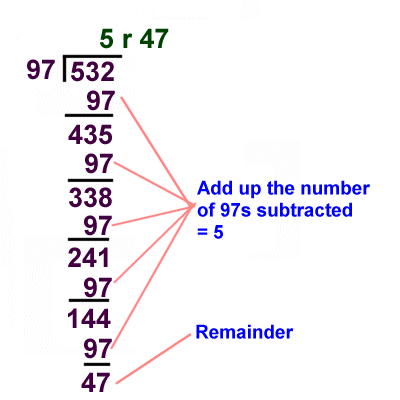

#HOW DO YOU DO DIVISION IN MATH HOW TO#
As they develop confidence and begin to understand how to do long division, start presenting them with problems that have a three-digit dividend, and then problems that have a two-digit divisor. Let students get comfortable with the formula and work on smaller problems. Have a discussion about why the steps work, and help them understand how place value plays an important role in the process. Remember that this is a totally new concept for students, so take the time to model problems on the board. Start with one-digit divisors and two-digit dividends to keep things simple.

Multiply the divisor by the quotient in the tens place column.Divide the tens column dividend by the divisor.The steps are more or less the same, except for one new addition: Now it’s time for students to tackle problems where the divisor doesn’t fit neatly into the tens orones column. Have them multiply the divisor by the quotient and add the remainder - the answer should be the same as the dividend they started with. This is a good time in the lesson to teach students how to check their answers. Make sure to model several problems as a class so students can begin to understand the steps and how to properly write their answers. The number they’re left with is the remainder. Subtract the product from the ones column.Multiply the divisor by the quotient in the right place column.Divide the ones column dividend by the divisor.But how many times does 5 go into 7, and what do you do with the leftovers? Now, begin with the tens column and work through the problem: 5 goes into 5 exactly once, so there’s nothing left there. That’s where you come in to save the day and explain how to do long division with remainders.įirst, show students a problem that has a remainder in the ones: Divide students into groups of three, four or six and give each group 50 cotton balls (or jelly beans, or pompoms, or marshmallows - whatever small object is accessible in your classroom).Īsk students to divide the objects up so each member of the group has an equal number, then watch and wait.Įventually, they’ll understand they can’t divide it evenly and there will always be some objects left over. Instead of jumping right into an equation with remainders, start with another object lesson. Have your students practise the step above until they’re comfortable with the basic format.

Teach students that when they’re asking how many times 2 can go into 4, they’re really asking how many times 2 goes into 40. Use these simple equations to reinforce place value. Then, repeat the step with the second digit in the dividend. Once they come up with the correct answer, put 2 above 4. This might be a tricky concept for them, so use the idea of sharing: If you want to share 4 objects between 2 people, how many objects does each person get? Ask students how many times 2 fits into 4. This next activity is good for helping students learn their divisibility rules. They can come in real handy for helping know what numbers will divide Try to answer as many problems in limited time. SUM SENSE DIVISION : Drag an Drop the number cards to make a correct division statement. Three different skill levels to choose from. Then turn over the yellow card and get ready to say “Gazinta!” or “No!”Ĭheck out the online division math games below.ĭIVISION MACHINE ACTIVITY : See how many points you can score with this division game. Player a few seconds to think about the number and what kinds of factors You prefer, you can turn over the blue card by itself, giving each Because 6 does not go into 49, whoever says “No!” first scores 1 point. Because 8 goes into 24, whoever says “Gazinta!” first scores 1 point.Įxample 2: The blue card is a 49 and the yellow card is a 6. Play up to a certain total (21 points, for example).Įxample 1: The blue card is a 24 and the yellow card is an 8. You can play for aĬertain amount of time (whoever has the most points wins), or you can The cards back in their decks, shuffle them, and turn over one blueĬard and one yellow card to begin another round. If the number on the blue card is NOT divisible by the number on the yellow card, the first player to say “No!” scores 1 point. (Because the number on the yellow card goes into-“Gazinta” - the number on the blue card. If the number on the blue card is divisible by the number on the yellow card, the first player to say “Gazinta!” scores 1 point.

Over one blue card and one yellow card so that both players can see them Cards and the yellow cards, keeping them in two separate decks.


 0 kommentar(er)
0 kommentar(er)
